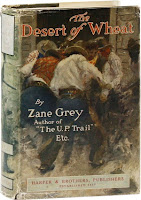An early day author of a novel and a Hollywood movie company were in our local territory at separate times years ago. They did a good job of using our natural scenery, but rather hectic stories emerged from their portrayal of our sacred wheat country that we all learned to love so dearly.
When I was a dreamy kid, I was forced to spend some of my choice teenage years in California. To relieve my torture, Lady Luck handed me Zane Grey’s novel, “The Desert of Wheat". It was concocted right after World War I. Zane spent part of a summer around the Almira-Hartline area, where he stimulated his imagination enough to create this special yarn.
Homesickness would set in when I read his description of those long sloping summer-fallowed fields south of Almira, where horses and their loads of drag-weeders were making dust that would hang in long ribbons across the fields in the evenings around about quitting time. Obsession would set in when Grey described how the summer breeze would make acres and acres of wheat wave. The chapter gathered a lot of thumb marks.
The IWW (International Workmen of the World), a rather nutty labor group, was raising hell in those days. They got into Zane Grey’s “Desert of Wheat” novel. He had these destructive characters burning wheat fields and things like that all over the Big Bend country.
In real life, stories got out that down in the Palouse Country the IWW’s were tossing lots of [unlit] matches on top of wheat stacks (settings). Later when the “hoe-downers” fed the mixture of unthreshed grain and matches into the speeding cylinder, a destructive fire would set in. Later the Palouse farmers found out that they were just growing too much smut*. A striking cylinder tooth would explode the excessive smut, giving the same effects that the IWW’s were accused of.
*Loose smut is a seedborne disease that is caused by the fungus Ustilago tritici. (Link)
"Harvesting Hollywood Style", Kik-Backs, page 27, part 1 (continued) (home)





.jpg)










Comments
Post a Comment